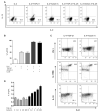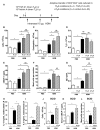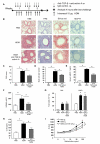Activin A and TGF-β promote T(H)9 cell-mediated pulmonary allergic pathology
- PMID: 22277204
- PMCID: PMC3385370
- DOI: 10.1016/j.jaci.2011.12.965
Activin A and TGF-β promote T(H)9 cell-mediated pulmonary allergic pathology
Abstract
Background: IL-9-secreting (T(H)9) T cells are thought to represent a distinct T-cell subset. However, evidence for their functionality in disease is uncertain.
Objective: To define a functional phenotype for T(H)9-driven pathology in vivo.
Methods: We used fluorescence-activated cell sorting to identify circulating T(H)9 cells in atopic and nonatopic subjects. In mice we utilized a model of allergic airways disease induced by house dust mite to determine T(H)9 cell function in vivo and the role of activin A in T(H)9 generation.
Results: Allergic patients have elevated T(H)9 cell numbers in comparison to nonatopic donors, which correlates with elevated IgE levels. In a murine model, allergen challenge with house dust mite leads to rapid T(H)9 differentiation and proliferation, with much faster kinetics than for T(H)2 cell differentiation, resulting in the specific recruitment and activation of mast cells. The TGF-β superfamily member activin A replicates the function of TGF-β1 in driving the in vitro generation of T(H)9 cells. Importantly, the in vivo inhibition of T(H)9 differentiation induced by allergen was achieved only when activin A and TGF-β were blocked in conjunction but not alone, resulting in reduced airway hyperreactivity and collagen deposition. Conversely, adoptive transfer of T(H)9 cells results in enhanced pathology.
Conclusion: Our data identify a distinct functional role for T(H)9 cells and outline a novel pathway for their generation in vitro and in vivo. Functionally, T(H)9 cells promote allergic responses resulting in enhanced pathology mediated by the specific recruitment and activation of mast cells in the lungs.
Copyright © 2012 American Academy of Allergy, Asthma & Immunology. Published by Mosby, Inc. All rights reserved.
Figures





Comment in
-
Reply: To PMID 22277204.J Allergy Clin Immunol. 2012 Sep;130(3):818-9. doi: 10.1016/j.jaci.2012.05.048. Epub 2012 Jul 11. J Allergy Clin Immunol. 2012. PMID: 22795372 No abstract available.
References
-
- Doull IJ, Lawrence S, Watson M, Begishvili T, Beasley RW, Lampe F, et al. Allelic association of gene markers on chromosomes 5q and 11q with atopy and bronchial hyperresponsiveness. Am J Respir Crit Care Med. 1996;153:1280–4. - PubMed
Publication types
MeSH terms
Substances
Grants and funding
LinkOut - more resources
Full Text Sources

